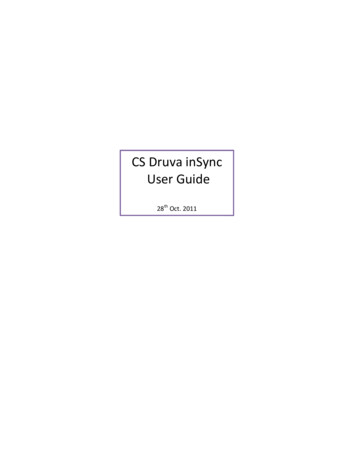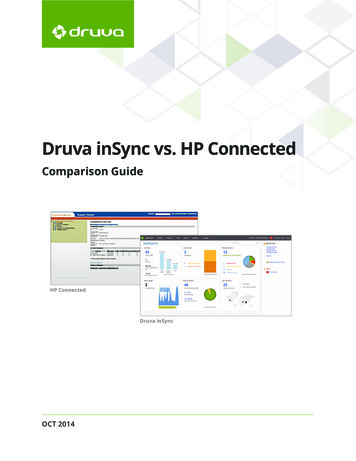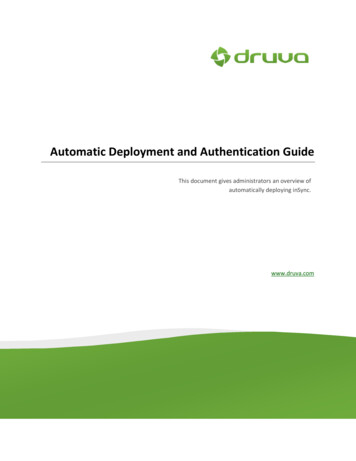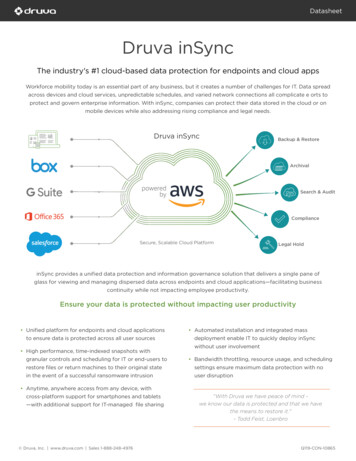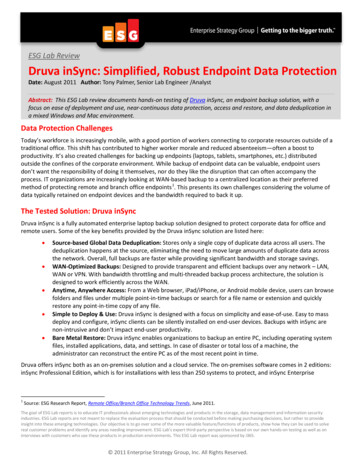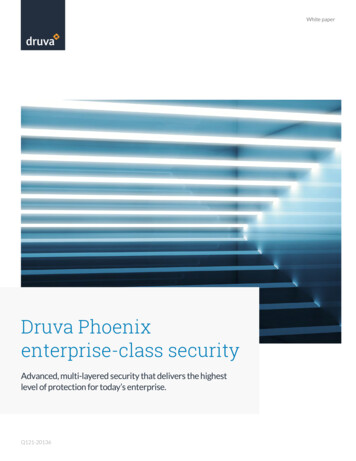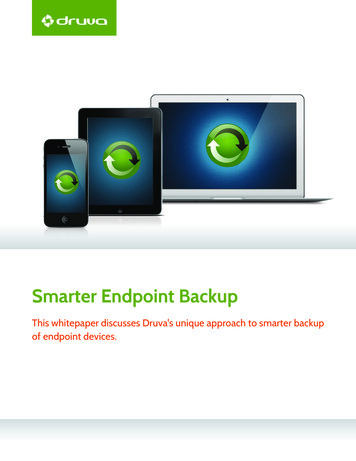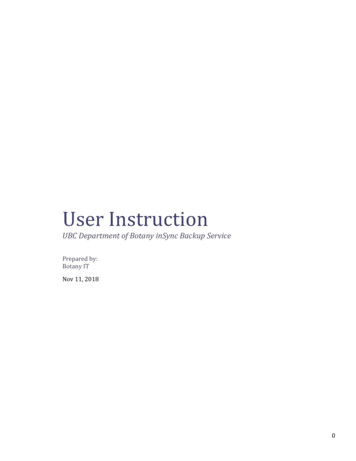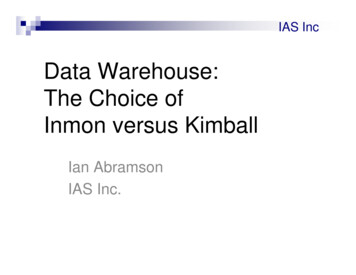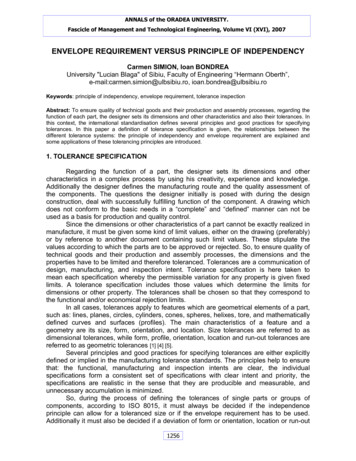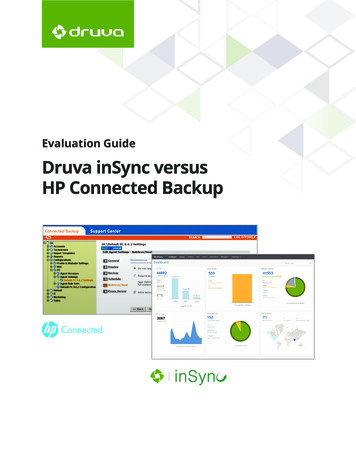
Transcription
Evaluation GuideDruva inSync versusHP Connected Backup
Druva inSync versus HP Connected Backup Evaluation GuideTable of ContentsExecutive Summary. 3Common Enterprise Concerns with HP Connected Backup. 3Feature Comparison. 4Data Deduplication. 4Data Governance. 5Mobility and BYOD Support. 6Deployment, Installation, and Management. 8Performance. 10Data Protection. 11IT-Managed File Sync and Share. 12Conclusion. 13Comparison Summary. 142
Druva inSync versus HP Connected Backup Evaluation GuideExecutive SummaryThis evaluation guide is designed for IT professionals looking for a modern approach to endpoint backup,and for an alternative to HP Connected Backup. The information provided in this guide is based on feedbackfrom customers who have switched from HP Connected to Druva inSync.Traditional endpoint backup such as HP Connected Backup was designed to backup data on desktopcomputers. With the rise of mobile computing, this legacy solution was subsequently adapted to handlebackup for endpoints (laptops, smartphones, and tablets). As a result, legacy solutions like HP ConnectedBackup offer limited support for efficient data deduplication, data transfer over variable bandwidths, andbackup across varied types of mobile devices. In addition, HP Connected Backup offers only basic securityfeatures, and its IT interface requires significant effort to install, deploy, and maintain.In contrast, Druva inSync was designed for today’s dispersed data environment brought about by the riseof the mobile workforce. Designed to protect and govern data on endpoint devices, Druva inSync featuresadvanced deduplication, eDiscovery enablement, WAN optimization, full mobile data backup, and data lossprevention. Centralized management with integrated mass deployment makes installing and managinginSync simple for IT.The overview below compares the features of Druva inSync with HP Connected Backup across several keycategories, including: data deduplication, mobility and BYOD, installation and management, performanceand end user experience, and security.Common Enterprise Concerns with HP ConnectedBackupA common issue with HP Connected Backup is its slow and intrusive operation. Due to the less thanoptimal impact on end user productivity, users often turn off backups, leaving data unprotected.HP Connected Backup does not protect against data breach for lost or stolen endpoints.HP Connected Backup is licensed per device; it does not support the notion of multi-device ownershipor multiple devices being backed up by a single user.HP Connected Backup has minimal support for mobility or BYOD, with data access for a limited numberof operating systems and device types.A common customer complaint is that HP Connected Backup is difficult to install and deploy, and requiressignificant IT effort to manage.HP Connected Backup requires significant bandwidth and storage, adding to its high TCO.HP Connected Backup does not continually protect data; it only offers daily backups.HP Connected Backup cannot enable efficient OS migration or laptop refreshes as it does not back upsystem data and application settings.3
Druva inSync versus HP Connected Backup Evaluation GuideFeature ComparisonData DeduplicationThe quality of data deduplication in an endpoint backup solution can significantly impact end-user productivity, data availability, and overall costs.Data Deduplication TechniqueHP Connected BackupDruva inSyncFile levelObject levelNoYesAttachments onlyMessages and attachmentsGlobal deduplicationApplication-aware deduplicationEmail deduplicationHP Connected BackupHP Connected Backup offers basic block-level deduplication, resulting in minimal reduction of the volume of backup data. This has a limited impact on bandwidth and storage, resulting in backup processesthat are large and slow.Delta Block deduplicates at the file level.SendOnce eliminates duplicate files across user archives.Optional, PC-only email optimization deduplicates attachments only.Druva inSyncDruva inSync employs global, client-side, application-aware deduplication technology, resulting in backups that require 80% less bandwidth and storage than do other solutions -- particularly when comparedto HP Connected Backup.Deduplicates data at the object level (sub-file level).Deduplicates data across all users and their devices.Deduplicates data at the client side, which reduces bandwidth requirements.Application-aware deduplication eliminates duplication of objects within and across file types by takinginto account the on-disk formats used by commonly-used applications (Outlook, Microsoft Office, PDF).Deduplicates Outlook data by using its MAPI interface to identify message folders and determine newlyadded, changed, or deleted messages.HyperCache, Druva inSync’s server-side selective in-memory cache, reduces disk I/O by up to 90%. Thatgives significant wins in scalability.4
Druva inSync versus HP Connected Backup Evaluation GuideData GovernanceEndpoint backup solutions do more than simply back up data. They also can enable litigation readinessto extend the value of your data protection strategy.Visibility and Control OverEnd-User DataHP Connected BackupData loss preventionDruva inSyncNoYesCloud applicationsNoMicrosoft Office 365 (Box,Google Drive coming soon)eDiscovery enablementNoYesProactive complianceNoYesHP Connected BackupNo integrated legal hold or eDiscovery enablement.Separate eDiscovery solution needed.No administrative or user audit trails.No data loss prevention capabilities, resulting in high economic impact when a device is lost or stolen.Druva inSyncDruva inSync combines user data across laptops, mobile, and cloud applications (beginning with Office365) to provide centralized visibility, full-text search, and management to meet enterprise data governance needs. From a single, unified dashboard, IT easily can create data policies, automate compliancemonitoring, administer legal holds and provide access for eDiscovery — all without impacting employeeproductivity in the smallest way.Federated, full-text search enables administrators to locate data in any file across all users, devices, andstorage locations. This makes it easier to find information for compliance and legal needs.Automated monitoring searches across end-user data sources; it alerts stakeholders of potentialrisks from the use or distribution of sensitive data (e.g. Protected health information (PHI), Personallyidentifiable information (PII), Payment card industry (PCI)).Preconfigured compliance templates provide pre-built configurations for the most common dataregulations.Built-in legal hold workflow facilitates the collection and preservation of relevant custodian data for legalteams while maintaining employee productivity.Remote wipe of data stored on lost or stolen devices can prevent expensive data breaches.5
Druva inSync versus HP Connected Backup Evaluation GuideMobility and BYOD SupportGiven the rise in the number of mobile employees and the amount of data stored beyond the corporatefirewall, support for mobile devices and workflows is critical in any endpoint backup solution.Mobility and BYOD SupportHP Connected BackupDruva inSyncMulti-device ownershipNo, licensed per deviceYesTablets onlySmartphones and tabletsSelf-restore onlyYesNoYesMobile appsSelf-deploy and self-restoreData backup for smartphones andtabletsHP Connected BackupHP Connected Backup has minimal support for mobility or BYOD. Data access works only with a limitednumber of operating systems and device types.HP Connected Backup backs up only Windows and Mac laptops. Linux users are out of luck.Mobile apps are available only for Apple iPad and Android tablets.HP Connected Backup is licensed per device. It does not support the notion of multi-device ownershipor multiple devices backed up by a single user. In addition to costing more per user (since each devicehas to paid-for separately), it means more management complexity, because IT has to track which usersown which devices. (Just what you needed: More work!)Connected iPad application is for access only and does not protect data on tablets.HP Connected Backup’s tablet apps provide end-users with access only (that is, you can look at the datastored elsewhere). The tablet software does not backup corporate data or protect data on the devicewith mobile data loss prevention (DLP).6
Druva inSync versus HP Connected Backup Evaluation GuideConnected client allows restores only from a single deviceinSync provides a multi-device view for access and restoreHP Connected Backup must be deployed by IT. It cannot be self-deployed by users. (More work for theIT department!)Druva inSyncDruva inSync covers a broad variety of OS and device platforms including Windows, Mac, Linux, AppleiOS, Android, and Windows 8 mobile.Druva inSync has a single license per user, for any number of devices.Users can self-deploy and self-restore their devices. IT can set up policies to limit access or otherwisemake sure the user gets what she needs (and not the things to which she should not have access), butcertainly the user does not require IT intervention. This makes users happier, and prevents IT help desksfrom having to answer 2:00am phone calls. Result: Less crankiness all around.Users can access and restore data backed up from any device using the client, inSync Web, or the mobileapp. It’s their data, wherever it happens to reside.Device and snapshot views of the inSync iPhone Application7
Druva inSync versus HP Connected Backup Evaluation GuideThe Druva inSync mobile app backs up corporate data for both corporate and BYOD smartphones andtablets.Data loss prevention capabilities allow corporate data to be remotely wiped from devices. That is:When a user leaves his phone on the plane, inSync can delete the company data (and optionally otherinformation, such as those adorable cat photos; or everything on the device) from the phone. Then theonly expense is buying a new phone (which can be provisioned with the always-backed-up data), andthe business doesn’t have to worry about the data getting into the wrong hands.File sharing lets users securely collaborate while providing IT visibility and control over corporate data.inSync Mobile PoliciesDruva inSync’s BYOD-related policies allow IT administrators the flexibility to manage user-owneddevices. In other words: It’s all under IT’s control, so while you can give users power, you don’t have todepend on them having a clue. Among those policies, for example, is the ability to enable mobile deviceaccess and mobile sharing based on a user profile, or to limit where certain actions can be done (suchas permitting mobile backup only over Wi-Fi networks).Deployment, Installation, and ManagementThe ease and speed of deployment of an endpoint backup solution can reduce overall costs and enablemore efficient use of limited IT resources.Installation and ManagementHP Connected BackupDruva inSyncYesYesRequires custom scriptsYesDaysMinutes1-click configurationNoYesCentralized administrationYesYesSilent deploymentNo custom scripting requiredInstallation time8
Druva inSync versus HP Connected Backup Evaluation GuideConnected Administrator ConsoleinSync Administrator ConsoleHP Connected BackupHP Connected Backup requires significant IT time and effort to install and maintain.Mass deployments require IT to write custom scripts.HP Connected Backup requires installation of several Connected Data Center servers (registrationserver, backup server, Web server), Support Center, Account Management Website, and ConnectedBackup databases. That’s a lot to manage.Admins must set up communities and accounts, create agent configurations, and set up complex rulesets with file inclusions and exclusions before backups and restores can be initiated.HP Connected Backup’s Support Center interface is inefficient for administration and management ofa large number of users and devices.Druva inSyncinSync features integrated tools, pre-configured options, and a visual interface for simple installationand maintenance.With its in-built mass deployment tools, inSync does not require custom scripts to be written. DruvainSync’s integrated mass deployment relies on Active Directory, Microsoft CCM, and Casper (JAMFsoftware) -- tools that administrators already know -- to deploy Druva inSync clients without userinvolvement.Druva inSync can be set up on-premise in a matter of minutes.Preconfigured user-profiles can be easily extended to create new ones, so administrators can roll ot newuser types without breaking a sweat.One-click quick configuration allows administrators to set up commonly-used data sources for backup,such as email, desktop, and documents.A centralized administrative console gives administrators seamless management of users, policies, anddata across inSync storage nodes. The same set of profiles and policies can be applied across endpointbackup, file-sharing, and DLP.Global real-time federated search helps administrators to quickly locate a specific file on any endpoint.Reports and data analytics give everyone a view from a height or in great detail with out-of-the-box reportfilters: detailed information on users, devices, files, versions (restore points), date modified, and size.Watch the watcher: View administrator activities with an undeletable stream of all activities includingmanaging users, data, storage, and reports.9
Druva inSync versus HP Connected Backup Evaluation GuidePerformanceHow your endpoint backup solution handles variable bandwidths and environments impacts end-userproductivity as well as the reliability and integrity of your data backups.End-user ExperienceHP Connected BackupDruva inSyncYesYesNo, only maximumbandwidth capsYesCPU throttlingNoYesWAN optimizationNoYesBandwidth capsPercentage-based bandwidth throttlingHP Connected BackupHP Connected Backup has limited bandwidth-throttling options and data-reduction techniques. Becausethe backup demands so much system attention, backups are intrusive for users. That motivates themto turn off the client, leaving data unprotected.HP Connected Backup offers only maximum bandwidth caps.Its over-simplistic deduplication techniques have minimal impact on bandwidth and storage. So thesoftware consumes system and network resources, and uses far more storage than it ought.Druva inSyncDruva inSync has multiple bandwidth throttling options and advanced deduplication techniques.Backups take place in the background -- as they should -- without bothering users in the least; dataremains continuously protected.Druva inSync dynamically throttles bandwidth during backups with percentage-based bandwidththrottling. Administrators (and users, if enabled) can specify bandwidth usage as a percentage of whatis available.Druva inSync also offers maximum and minimum bandwidth caps.With Druva inSync’s CPU throttling, CPU priority can be assigned so that backups do not interfere withusers’ high-priority applications. (If you need to get that project done on Friday afternoon, the last thingyou want is the backup utility grabbing all the computer’s attention.)The WAN optimization engine analyzes available network resources, selects the appropriate packet size,and spawns multiple threads to make the best use of the available bandwidth. Interrupted backups andrestores are automatically resumed.Advanced deduplication at the client-side minimizes bandwidth and storage requirements for smaller,faster backups.10
Druva inSync versus HP Connected Backup Evaluation GuideinSync bandwidth and CPU throttling from the clientinSync bandwidth & CPU throttling from theadmin consoleData ProtectionBackup solutions should enable continuous and seamless backup and restores for protecting criticalbusiness data wherever it resides.Data ProtectionManual and automatic backupsContinuous data protectionSystem and application settings backupConnected Backup SchedulingHP ConnectedBackupDruva inSyncYesYesDailyMinutesNoYesinSync Backup SchedulingHP Connected BackupHP Connected Backup allows manual backups or automatic backups at a daily frequency. HP ConnectedBackup backs up data only and does not backup any personal settings.11
Druva inSync versus HP Connected Backup Evaluation GuideDruva inSyncinSync gives you continuous and non-intrusive data protection, not just daily snapshots. It can be configured to backup changes within minutes of their occurrence, without interfering with end-user productivity. If even that isn’t often enough, inSync allows end users and administrators to initiate manualbackups at any time.inSync is the only endpoint backup solution to backup personal settings as well as data. With inSync’sPersona Backup, which goes beyond backing up only user data, users can get right back to work in theirfamiliar environment, saving them extensive time re-configuring device settings.inSync eliminates the need for time- and resource-intensive bare metal restores on laptops. This saves endusers time spent in manually reconfiguring settings to get back their familiar working environment. (Giveme my favorite desktop background! And re-set my schedule notification defaults the way I want them!)inSync enables efficient OS migrations and laptop refreshes with self-service restore of data, as well assystem and application settings.IT-Managed File Sync and ShareGives IT teams control and visibility over business data, while also appealing to the user needs of simpleand easy access.HP Connected BackupHP Connected Backup does not offer integrated file sharing, requiring organizations to purchase aseparate file sharing solution.Druva inSyncinSync integrates endpoint backup with enterprise-ready file sharing. This gives IT visibility and control,and employees can collaborate on file collections without having to break IT’s data sharing policies. Plusthey get ease-of-use and a single-client experience.Users can selectively sync shared folders to their devices or simply view shared folders on the inSyncWeb client.Mobile sharing works with iOS, Android, and Windows 8 Mobile.Files can be shared with external collaborators via automatically expiring links, to prevent outsidersfrom access to data long after they need it.To further control access to corporate data, view-only links display files in-browser using Druva inSync’sdocument viewer, and thus prevent downloads.Policy management allows IT to configure sharing permissions within and outside the organization,enable sharing on mobile device, and setting data-retention policies.Real-time user activity streams shed light on sharing patterns within the enterprise and offer visibilityinto the location of sensitive corporat
HP Connected Backup does not protect against data breach for lost or stolen endpoints. HP Connected Backup is licensed per device; it does not support the notion of multi-device ownership or multiple devices being backed up by a single user. HP Connected Backup has minimal support fo
